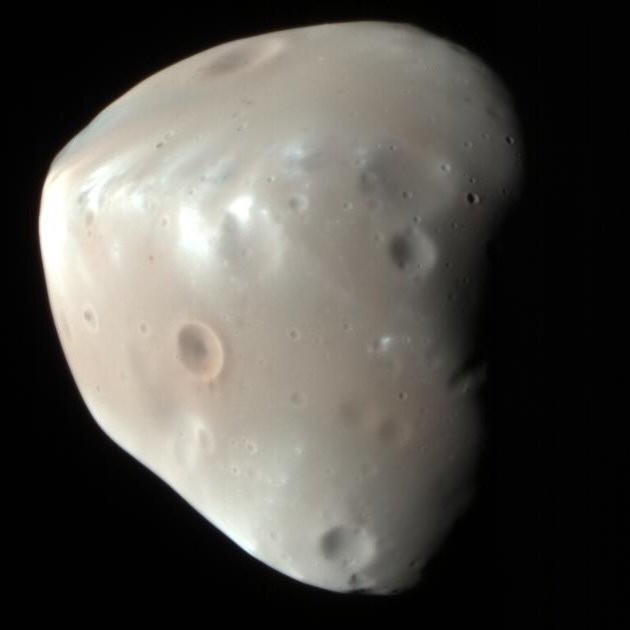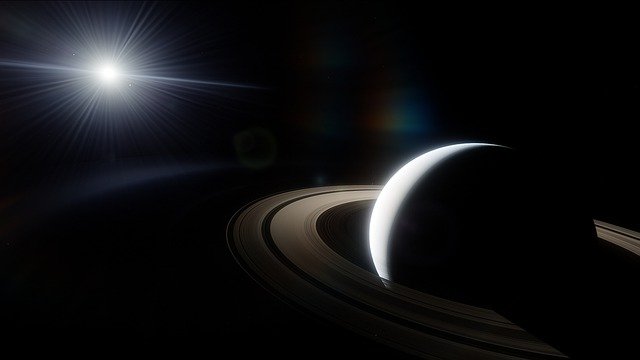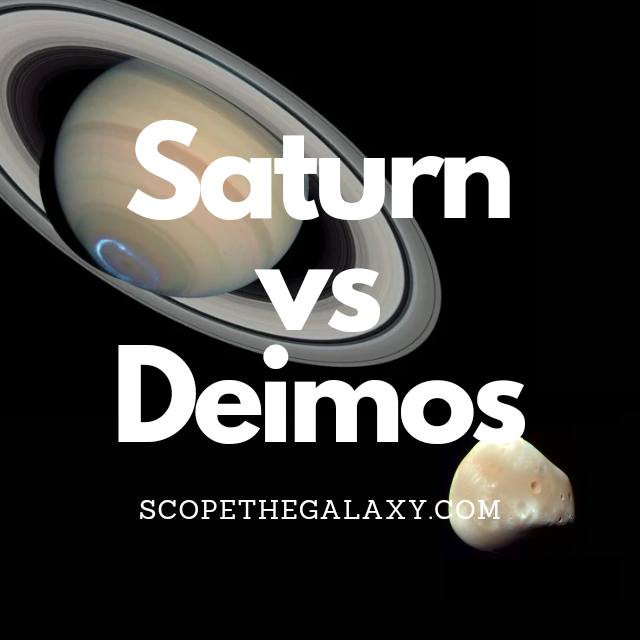*This post may contain affiliate links. This means we may make a commission if you purchase an item using one of our links*
The main differences between Saturn and Deimos are that Saturn is a gas giant planet while Deimos is a natural satellite, Deimos orbits Mars while Saturn has 81 moons orbiting it, Saturn is significatly larger with a diameter of 116,460km compared to Deimos’ is 12.4km and Saturn has 7 very visible rings orbiting it while Deimos doesn’t have any rings.
There are various other differences between the two so, continue reading if you want a more detailed look at each body along with their similarities and differences below.
What Is The Moon Deimos?
Table of Contents

Deimos is the smaller and outermost of the two moons of Mars, named after the Greek God of dread and terror (the brother of Phobos). This satellite was also discovered by American astronomer Asaph Hall just five days before Phobos (12th August 1877).
Scientists like Johannes Kepler had put forward theories for the existence of these moons many years before they were discovered. Their calculations were based on the fact that the planets on either side (Earth and Jupiter) possessed one and four moons, respectively.
Still, none were discovered until the 19th century. One of the main reasons for this is that the tiny size of Phobos and Deimos, combined with an exceptionally close orbit to their planet, means that the glare of Mars often obscures our view of them.
Phobos measures just 15 x 12 x 11 km and completes an orbit of Mars once every 30 hours.
This tiny moon is also a heavily cratered landscape shaped by the impact of asteroid collisions over time. However, the material thrown up from these impacts doesn’t appear to have landed back on the moon’s surface as it usually would. This could be because the lack of gravity on Phobos allowed the ejected material into space.
The surface gravity on Deimos is just 0.003 m/s^2 (compared to 9.807 m/s^2 on Earth), which means the average gravitational pull of Deimos is only 0.003 m/s. With only 1/2500th of Earth’s gravity, you would need a tether to walk on this rocky moon, or every step would put you at risk of achieving escape velocity and launching yourself into space.
The composition of Deimos is similar to Phobos, suggesting that it might also be a captured asteroid. Its surface is very dark gray and has an albedo of around 0.07, meaning it reflects just 7% light (about half of the light Earth’s moon can reflect).
What Is The Planet Saturn?

Saturn is the second largest planet in our solar system, that has a multitude of rings surrounding its gaseous exterior. It’s also the 6th farthest planet from the Sun.
As Saturn falls under the gas giant moniker, the planet is mostly made up of gases. However, Saturn’s composition is a little different from Jupiter’s where its atmosphere is mixture of hydrogen and ices containing elements of Ammonia.
It’s core on the other hand is comprised of a dense core of nickel and iron, which is then surrounded by rocks compressed so strongly that it can tends to reach scorching hot temperatures of 11,700+ degrees celsius.
On the other hand, It’s gaseous atmosphere is far cooler. The exterior generally sits in the extreme sub zero range where Saturn’s temperatures is -138 degrees celsius.
This is generally constant throughout the yellow ringed giants day to day. In fact it’s much colder than even the coldest place on Earth, which would be Eastern Antarctic Plateau, Antarctica that hits -94 degrees Celsius, which is more than 40 degrees celsius warmer.
Being so large (116,460km), Saturn’s gravitational pull is obviously strong. That’s why over it’s 4.5 billion years of existence, beyond its rings this yellow gas giant has managed to accumulate 82 different moons along with other smaller interstellar debris that now orbit it.
In fact it’s largest moon Titan is literally bigger than one of the 8 planets orbiting the Sun, Mercury.
Saturn also orbits the Sun but, as the 6th farthest planet from it, it does mean a singular orbit will take it 29.4 Earth years to complete. In comparison to its axial orbit which only takes 10.7 hours, this is an extremely long time.
Similarities Between Deimos And Saturn
There are a few similarities that Saturn and Deimos share, which in this case includes the following:
- Both are part of the same solar system.
- Neither have tectonic plates.
- Both orbit another larger object.
Differences Between Deimos And Saturn
As for the differences between the two, they include the below.
- Deimos orbits Mars whilst Saturn only orbits the Sun.
- Saturn is a spherical shape while Deimos is not.
- Saturn has 81 moons orbiting it while Deimos has none.
- Saturn is a gas giant planet whilst Deimos is a terrestrial based natural satellite.
- Saturn has a diameter of 116,460km whilst Deimos has a diameter of 12.4km.
- Deimos has no atmosphere whilst Saturn is composed of helium and hydrogen.
- A day on Deimos takes 30 hours whilst a Saturn day takes 10.7 hours.
- It takes Deimos 30 hours to orbit Mars and the Sun in 687 days whilst Saturn orbits the Sun 29.4 years.
- Deimos’ temperature ranges between -4 to -112 degrees Celsius whilst Saturn’s average temperature is -138 degrees Celsius.
- Saturn has an axial tilt of 26.73 degrees whilst Deimos’ axial tilt is closer to 0.
- Saturn’s density is 0.687 g/cm³ whilst Deimos density is 1.47 g/cm³.
- Saturn’s mass is 5.683 × 10^26 kg whilst Deimos’ mass is 1.4762 × 10^15 kg.
- Deimos’ gravitational strength is 0.003 m/s² whilst Saturn’s is 10.44 m/s².
- Deimos is tidally locked to Mars whilst Saturn is not tidally locked to any entity.
- Saturn has magnetosphere whilst Phobos has no magnetic field.
- Deimos has no core while Saturn has a hot central core.
- Saturn has 7 rings while Deimos has 0.
Summary
Saturn and Deimos share very few similarities, which would include them being a part of the same solar system and having no tectonic activity but, they definetly have way more differences.
Whether it be in regards to mass, size, physical composition, orbital period, density and more they differ significantly, which is why Saturn looks and functions so very distinctly from Deimos and vice versa.

